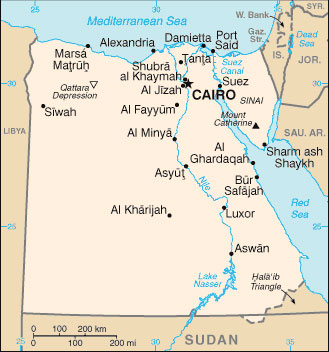
ARAB REPUBLIC of EGYPT
Location: North Africa, bordering the Mediterranean Sea, between Libya , the Gaza Strip, the Red Sea, north of Sudan
Capital: Cairo
Area: 1,001,450 sq km
Coastline: 2,450 km
Elevation extremes:
lowest point: Qattara Depression -133 m
highest point: Mount Catherine 2,629 m
Official language: Arabic
Other spoken languages: English, French
Population: 76,117,421
Age structure: 0-14 years: 33.4%
15-64 years: 62.2%
65 years and over: 4.3%
Currency: Egyptian Lira
Member: Arab League
Egypt is a founding member of the Arab League, whose headquarters are in Cairo. The head of the Arab League, Amr Moussa, is Egyptian. The country is situated in North Africa, bordered on the north by the Mediterranean Sea, on the east by the Red Sea, on the west by Libya and on the south by Sudan. It has an area of 1,001,449 sq km. Its capital is Cairo; a modern, densely populated megacity with an underground metro. Other cities are Alexandria, Giza, Port Said, Asyut, Aswan, Tanta, Siwa. Egypt has a population of 68million.
Egypt’s terrain is desert except for the fertile land on either side of the Nile River and in the Nile Delta. The tributaries that form the Delta are Dumyat in the east and Rashid in the west. There are mountainous areas; Mt Catherine (2637m) is in southern Sinai, and home to The Monastery of St Catherine.
To the west of the Nile is the western, or Libyan Desert, a sandy plateau with an area of 681,000sq km, marked by several depressions. The lowest is Qattara Depression, 134m below sea level. There are some large oases and irrigated agricultural areas. The eastern desert stretches from the Nile to the Red Sea, and there is a granite mountain range along the Red Sea with a peak at Jebal Shayeb (2187m). The Sinai Peninsula to the north and east of the country is a sandy desert.
Egypt’s climate is very hot in the deserts with no rainfall. Along the Mediterranean the weather is mild with seasonal rainfall. There is a frequent hot, dust-laden wind called khamsin.
Egypt is an ancient country renowned for its Pharaonic treasures at Luxor, the Pyramids at Giza and Abu Simbel. The last native Egyptian dynasty fell to the Persians in 341BC, then to the Greeks, Romans, Byzantines, and Persians again and finally to the Arab Muslims who introduced Islam and the Arabic language in the 7th century. In 1517 it was conquered by the Ottoman Turks till 1805 and ruled by Mohammed Ali Pasha. Ahmad Orabi led a revolt against the occupation 1879-1882. In September 1882, the British intervened and took control of Egypt 1882. Orabi was exiled to Sri Lanka.
Egypt was a monarchy till 1952, when a popularly supported military coup forced King Farouk to abdicate. Egypt became a republic in 1953; Gamal Abdel Nasser assumed power in 1954. He formed a short-lived United Arab Republic with Syria 1958- 1961.
Upon Nasser’s death he was succeeded by Anwar Sadat as President; he was assassinated in 1981, and succeeded by Hosni Mubarak.
Egypt’s economy depends on agriculture, tourism and services. There is continued investment in Red Sea resorts. Agricultural production is consistently improving with desert lands being developed for farming. With hardly any rainfall, 100% of the land – 25,000sq km -- is irrigated by the Nile.
Products are rice, cotton, corn, wheat, citrus, onions, fava beans, sugar cane, potatoes; livestock : sheep, goats, cattle, camels, donkey, chickens and ducks). There are small canal-irrigated farms along the Nile with water buffalo and cows and chickens. There is also fishing in the Red Sea and Mediterranean.
Egypt’s natural resources are petroleum, natural gas, phosphates, lead, zinc, iron ore, manganese, and salt.
Industries are textiles (cotton), petroleum products, aluminum, foodstuffs, weapons, electrical appliances. Hydroelectricity accounts for 21% of electricity needs and is produced at the Aswan High Dam.
The Suez Canal was completed in 1869. It is a 163km shipping canal between Port Said on the Mediterranean and Suez on the Red Sea. It allows water transport from Europe to Asia without going around the Cape of Good Hope. Egypt has oil pipelines that run parallel to the canal, competing with oil tankers that have to circumnavigate the African continent.
The Aswan High Dam is the largest river dam in the world, and was completed in 1971.
Egypt faces environmental problems with the pollution of the Nile, the major source of water in the land.
Cities: Cairo, Alexandria, al-Fayoum, Port Said, Suez, al-Giza
Nature reserves: Ras Mohamed National Park, Nabq Managed Resource Protected Area, Omayed Biosphere Reserve, Wadi Allaqi Biosphere Reserve
Egypt’s Constitution, Universities, Tourism


